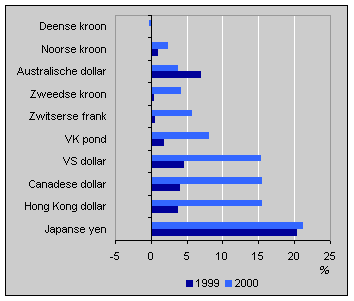Currency exchange rates in 2000

In the first ten months of 2000 the value of the American dollar and the Japanese yen rose strongly against the Dutch guilder. Compared with its average rate of 2.17 guilders in January, by October the dollar was worth 41 cents more, an increase of 19%. Since then it has been weakening, and on 15 January this year one dollar cost 2.34 guilders.
The exchange rate of the Japanese yen has followed closely in the dollar’s footsteps since the end of 1999. In October the yen reached a record level of 2.38 guilders per 100 yen, 15% up on its January level, but this too has fallen, to under two guilders by mid January this year.
Currency exchange rates (monthly averages)

Compared with the dollar, the value of the euro, to which the Dutch guilder is pegged, is determined to an important extent by the confidence of the financial markets in the economies of the Eurozone and the United States (US). This confidence is based on among other things differences in economic growth.
In 1999 and the first half of 2000 economic growth in the US was constantly 2 percentage points higher than in the Eurozone. In the third quarter of last year growth levelled off both in the US and in Europe. The 2.8% growth rate for the European Union (EU) predicted by the Netherlands Bureau for Economic Policy Analysis for this year is some 0.5 of a percentage point below last year's growth rate. But the slowing down foreseen for economic growth in America is much greater (from 5.2% in 2000 to 3.3% in 2001). This tarnishes the attraction of the American economy for many international investors, which will in turn lead to a reduced demand for dollars on the currency market.
The guilder and the euro were also down on a number of currencies in Europe which do not participate in the single currency. The value of the pound sterling, the Swiss franc and the Swedish crown rose by an average 5% last year.
Average currency exchange rates (changes on previous year)

Frans van Ingen Schenau